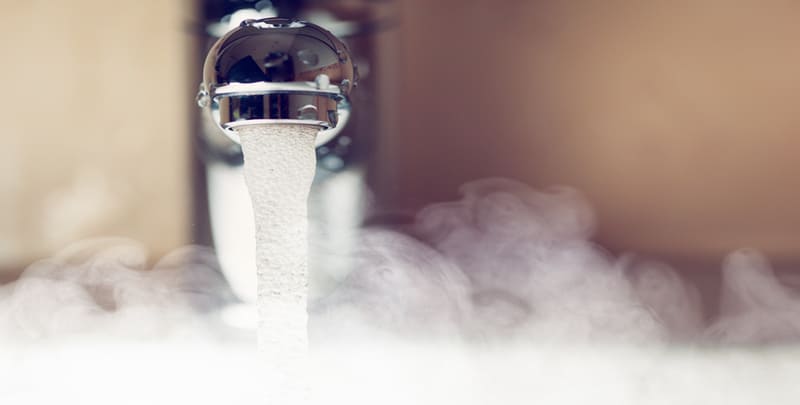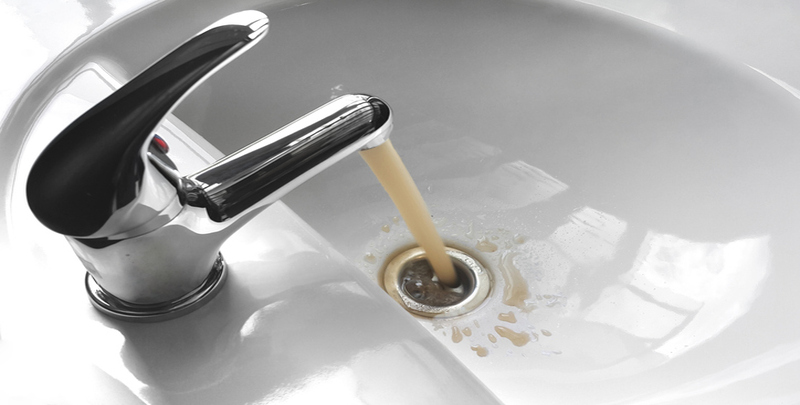Is Cloudy Water from the Tap Safe?

For most Australian homes, cloudy water is never an issue. However, there are several circumstances where you will have to deal with cloudy tap water.
Often these problems with cloudy drinking water are quickly resolved. The offending matter has likely passed through your plumbing already. However, there are times where the cloudiness persists. Your water quality has clearly been compromised and you find yourself dealing with a murky water supply.
It could be cloudy hot water, or discoloured tap water. Maybe it’s just the garden tap that’s spouting concerning liquid. If you find yourself wondering whether it’s safe to use, keep reading. Upside Down’s here to answer all your questions regarding cloudy or milky water.
Why Does Water Become Cloudy?
Water, or H₂O, is made from two gases; hydrogen and oxygen. It expands when it’s turned into either a solid (liquid) or gaseous state (steam). Minerals become trapped in the water along with a wide range of gases. In a hot water system, the molecules in the water expand and trap other gases due to pressure.
For the most part, the tiny air bubbles you see as water flows out of a tap is oxygen. The slight aeration is the main reason why your water appears to be milky or cloudy. Once out of the tap, the reduction in pressure allows gas to float to the top of the container and then escape into the air.
The water clears from the bottom to the top. You can watch as the tiny air bubbles rise up in a clear glass or bowl. This effect can also happen with extremely cold water, because water also expands when frozen. It’s all completely harmless.
However, your water pipes often contain other minerals, build up and debris. So it’s not just oxygen bubbles in the water. Discoloured water can occur due to contamination and that’s when you need to look into the quality.
When Should I Worry About My Water Supply?
There are times when cloudy tap water is a genuine concern. That’s when the water is tinted or muddy rather than a cloudy look that clears naturally.
Sometimes there’s little you can do. The cause could be the local council performing maintenance work nearby and, because you have no choice, you just have to sit back and let the problem resolve itself.
But if the muddiness lasts more than a few hours the problem could be more serious. The cloudy tap water could be a sign of damage to pipes or water heater issues. So, although cloudy water and cloudy hot water is almost always caused by pressure, rust and sediment is also an issue. Bacteria growth is especially worrisome.
Arguably, the most common cause of your discolouration will be sediment or excess minerals within the pipework and hot water system. This is especially likely if you have hard water, which is water that has a high concentration of dissolved minerals.
Sediment from rusted pipes will add a brown, murky tinge, while dirt could also mix with your drinking water supply if there’s an underground leak in your plumbing.
If you do have a storage tank water heater, pay attention to the water quality. Any sediment or discolouration is an indication of internal rust or contamination. Contaminated cloudy tap water is not something you want.

How to Test Your Water Quality
The easiest way to test your water supply is to fill a clear container with hot water and sit it on a flat surface.
You can use any kind of clear container – a glass, a bowl, a plastic jar. Anything you like.
If the water is cloudy you need to look for two things:
- Does it clear from the bottom to the top or the top down?
- How long does it take to clear? Or does it stay cloudy?
If it clears from the bottom and only takes a few minutes, then it’s oxygen bubbles in the water.
If your water doesn’t clear or is brown instead of cloudy or milky, you could be facing more serious problems with your pipes or hot water service. If this is the case, it would be wise to test other taps in the house and consider calling a plumber if the problem persists.
How Can I Fix Cloudy Water?
If your water has a cloudy or milky appearance, chances are you don’t have to do too much. The air bubbles are harmless and some cloudiness will go. But if it’s a serious problem that’s impacting the quality of your water, there are a few things you can do.
First, locate the tap farthest away from your water supply’s entry point. Turn it on and let the water flow for a couple of minutes. This flushes the system, meaning you should allow any sediment or discharge to pass through. But if it doesn’t go away, contact a licensed plumber.
If the issue is cloudy or milky hot water, your discolouration is probably caused by a storage tank. A plumber can flush the tank of debris and sediment. Meanwhile, a service should clear up any issues, like a rusted sacrificial anode.
If you have an aerator on any of your taps, this could also be causing the water to appear cloudy. Sometimes the aerator can become clogged, which increases water pressure and hence the cloudiness. This is a simple case of removing the blocked aerator and cleaning it.
Thankfully, cloudy hot water is often a minor problem caused by water pressure. And if your water pressure appears to be too high, a plumber can install a safety device known as a pressure limiting valve. But if the colour has turned brown and is not clearing up, call Upside Down for professional advice and to have your water tested.
Please note: This information is provided for advice purposes only. Regulations differ from state to state, so please consult your local authorities or an industry professional before proceeding with any work. See our Terms & Conditions here.